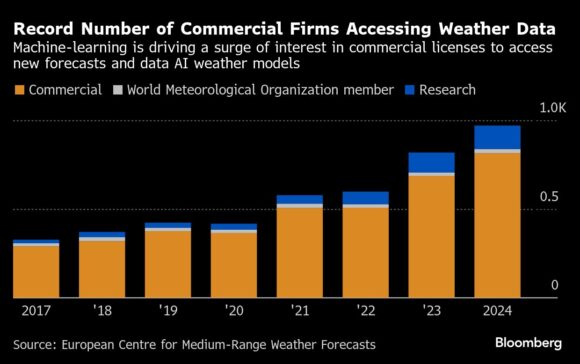Scientists and officials at ECMWF say artificial intelligence is fueling the boom, as customers feed the data into new machine learning tools. Those AI models are providing more accurate forecasts, giving traders and other companies a critical edge just as climate change raises the stakes by increasing the intensity and frequency of extreme weather events.

Energy traders seeking profitable bets in Europe’s increasingly wind- and solar-driven power markets were some of the earliest and most aggressive adopters of AI weather tools. DXT Commodities SA, a Swiss trading firm, uses hundreds of computer models to predict weather-driven shifts in power supply and demand.
“The keys of machine learning, really, are opening doors that before were simply closed,” said Lorenzo Ramella Pralungo, a weather analyst with DXT Commodities.
But the technology is increasingly pivotal to other industries with licensees from insurance, agriculture and media paying an average of about €36,000 ($42,200) a year to access data. That supplements the funding provided by ECMWF’s 23 member states.
Those data are increasingly used to train AI models programmed to predict how the atmosphere and oceans will look in the future by finding patterns in a massive archive held by the European forecaster. That library includes the world’s largest electronic record of weather observations — recorded by ground sensors, balloons, ocean buoys, aircraft and satellites — and the center’s own real-time forecasts.

ECMWF is set to stoke the weather-data frenzy further on Wednesday by making almost real-time forecasts freely available to download. By the end of this year, the center will also make higher-resolution data available, albeit with a two-hour delay.
Those data releases will likely stimulate new weather tools, said Dennis Schulze, chairman of PRIMET, the European trade association for private meteorological companies, and a founder of Berlin weather analytics firm MeteoIQ.
“Data is a fuel for these businesses,” he said.
The open data license will also resolve issues that previously prevented clients from distributing information, according to Schulze. That’s had some unintended consequences, such as barring shipping companies from dispatching weather forecasts to their fleets.
Free offerings by ECMWF typically stimulate commercial sign-ups, as firms seek to lock in tech support and the ability to customize how the data are formatted and electronically delivered, center officials said.
Turning Point
While feeding the machine-learning models of its clients, the European forecaster has also been quicker to adopt AI than other government weather institutions, said Hannah Christensen, an atmospheric scientist at the University of Oxford.
“They’re the only people who can do the entire workflow,” she said.
The turning point for the center came in 2023, when scientists at Alphabet Inc.’s Google DeepMind published research showing its GraphCast model outperforming ECMWF’s conventional two-week weather forecast, which is used by met offices around the world and closely watched by energy traders.
“It surprised a lot of people, us included, that it worked so well,” said Rémi Lam, a DeepMind research scientist who developed the model.

Since, then the European forecaster has rewritten its long-term strategy to embrace AI: In March 2025, it became the first government forecaster to release an operational AI weather forecast model and followed that in July with the first AI-powered ensemble forecast, using 50 weather simulations to predict how the atmosphere will likely behave in the future.
For scientists at ECMWF, AI is the biggest revolution in weather forecasting since the 1990s.
“That’s when satellites came online,” said Florian Pappenberger, the center’s deputy director-general who also heads the forecasting department. “That was the last time we had such a jump in skill.”
Top photograph: ECMWF Deputy Director-General and head of forecasting, Florian Pappenberger. Photo credit: Joe Wertz/Bloomberg
Was this article valuable?
Here are more articles you may enjoy.



 State Farm Sued Over Policies Backed by Distressed Insurer PHL
State Farm Sued Over Policies Backed by Distressed Insurer PHL  Dozens of State Attorneys General Urge Congress Not to Block AI Laws
Dozens of State Attorneys General Urge Congress Not to Block AI Laws  Why Reciprocal Insurance Exchanges Are Back in Fashion
Why Reciprocal Insurance Exchanges Are Back in Fashion  Applied Systems, Comulate Spar Over Trade Secret Theft Allegations
Applied Systems, Comulate Spar Over Trade Secret Theft Allegations 

